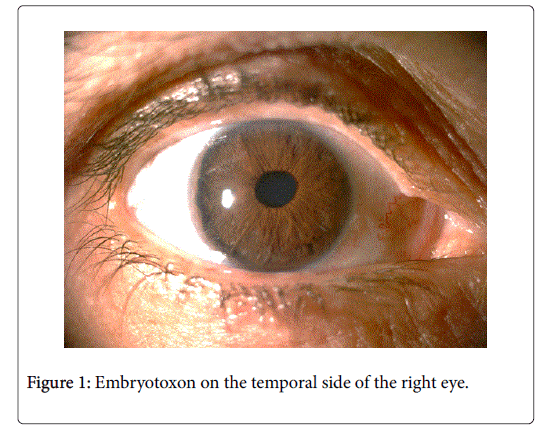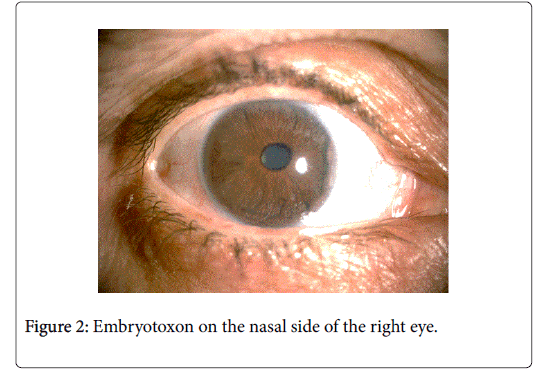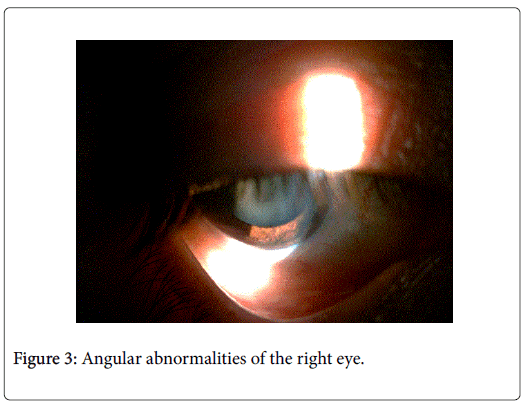Axenfeld-Rieger Syndrome
Received: 21-May-2018 / Accepted Date: 24-May-2018 / Published Date: 31-May-2018 DOI: 10.4172/2165-7386.1000336
Introduction
We report the case of a patient aged 47 who consult for a decrease in visual acuity. Examination of the anterior segment spotting unilateral irrido-trabecular dysgenesis of the right eye with abnormal visibility of the schwalbe line corresponding to a posterior embryotoxon and associated angular abnormalities (Figures 1-3).
The eye tone measured with Goldmann tonometer showed 14 mmHg in the right eye and 15 mmHg in the left eye. The examination of the fundus of the eye finds symmetrical morphology of the optic discs without pathological excavation.
The remainder of the somatic examination reveals no abnormality associated especially the absence of dental malformation. Chronic glaucoma is seen in 50% of patients [1]. The diagnosis of Axenfeld- Reiger syndrome uncomplicated of chronic glaucoma has been established, despite the absence of signs of Rieger [1]. No treatment has been established. Regular checks have been proposed to detect any complications including glaucoma.
Conclusion
This syndrome is inherited as an autosomal dominant manner. It is found that 2 genes are mainly involved in the transmission; PITX2 gene in 4q25, present in 10-60% of patients, mainly associated with systemic alterations such as dental malformations [2,3].
The other gene responsible is FOXC1 located in 6q25, present in 50% of cases and manifested by ocular alterations, especially glaucoma [2-4]. The differential diagnosis arises with the Peters anomaly which consists of a defect of the posterior surface of the cornea associated with a stromal opacity. Currently, it is suggested that all these abnormalities are actually part of the same syndrome, Axenfeld-Rieger syndrome [5].
References
- Alward WL (2000) Axenfeld-Reiger syndrome in the age of molecular genetics. Am J Ophthalmol 130: 107-115.
- Reis LM, Tyler RC, Kloss BA, Schilter KF, Levin AV, et al. (2012) PITX2 and FOXC1 spectrum of mutations in ocular syndromes. Eur J Hum Gene 20: 1224-1233.
- Strungaru MH, Dinu I, Walter MA (2007) Genotype-phenotype corre-lations in Axenfeld-Rieger malformation and glaucoma patients with FOXC1 and PITX2 mutations. Invest Ophthalmol Vis Sci 48: 228-237.
- Honkanen RA, Nishimura DY, Swiderski RE, Bennett SR, Hong S, et al. (2003) A family with Axenfeld-Rieger syndrome and Peters anomaly caused by a point mutation (Phe112Ser) in the FOXC1 gene. Am J Ophthalmol 135: 368-375.
- Chang TC, Summers CG, Schimmenti LA, Grajewski AL (2012) Axenfeld-Rieger syndrome: New perspectives. Br J Ophthalmol 96: 318-322.
Citation: Ould Hamed MA, Soulay AY, Reda K, Oubaaz A (2018) Axenfeld-Rieger Syndrome. J Palliat Care Med 8: 336. DOI: 10.4172/2165-7386.1000336
Copyright: © 2018 Ould Hamed MA, et al. This is an open-access article distributed under the terms of the Creative Commons Attribution License, which permits unrestricted use, distribution, and reproduction in any medium, provided the original author and source are credited.
Select your language of interest to view the total content in your interested language
Share This Article
Recommended Journals
Open Access Journals
Article Tools
Article Usage
- Total views: 6740
- [From(publication date): 0-2018 - Nov 28, 2025]
- Breakdown by view type
- HTML page views: 5805
- PDF downloads: 935



